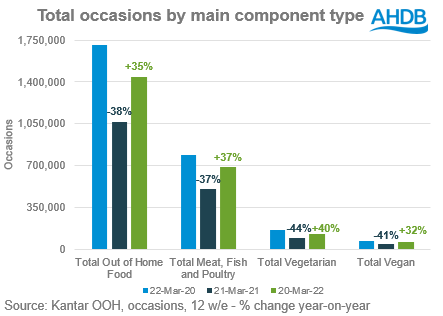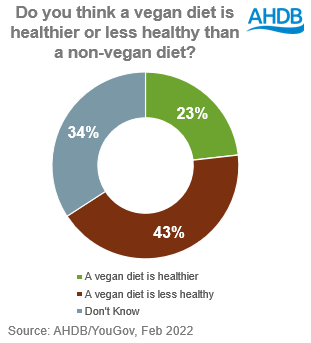Vegetarian and vegan dish recovery slow
Tuesday, 10 May 2022
Vegetarian and vegan foods have been increasing their share of menus in the out of home market in recent years as outlets look to cater to those with more dietary requirements including those looking for meat-free and plant-based options.
Vegetarian dishes remain the smallest proportion of menus with only 9% share of main meals (Lumina Intelligence Menu Tracker). Research from Kantar suggests that only 0.8% of the population are following a strict vegan diet and 5.6% claim to be following a vegetarian diet. Therefore, the majority of shoppers are still consuming meat. During the pandemic, shoppers needs shifted and with increased inflationary pressure, how have these trends impacted sales of vegetarian and vegan dishes in foodservice?
![]()
Vegetarian and vegan dish recovery
Vegetarian dishes are defined as all main meals which do not include meat. Vegan dishes are a subset of vegetarian dishes but exclude any meals which contain dairy or eggs.
Despite the growing share of menus, vegetarian and vegan dish sales were hit harder by the pandemic seeing larger declines than meat-based meals and recovery appears to be slower. Total foodservice occasions (number of time people go out to eat or order takeaway and delivery) were down 15% for the 12 weeks ending 20 March 2022 compared to the same period in 2020, but occasions for both vegetarian and vegan dishes were down 22% (Kantar). This is despite this time period covering January where some people may be taking part in meat reduction due to the Veganuary campaign. Vegetarian dishes are seeing the fastest trip increase year-on-year but this is due to their steeper decline during the pandemic.

Out of home spend has now recovered to pre-covid levels up 5% on 2020 but vegetarian dishes are tracking behind the market with spend only up 3% (Kantar, 12 w/e 20 March 22). Vegan dishes are performing well with spend up 8% on pre-pandemic but cheese and egg-based dishes have struggled, both still in decline compared to before the pandemic. This may be due to restaurants promoting more vegan foods during January and increasing menu space for vegan dishes over vegetarian ones.
Vegan dish trends
Vegan dishes are hugely reliant on quick service restaurants (QSR) with 40% of occasions through QSR compared to only 22% for total food. Vegan occasions have also seen growth faster than total food in QSRs. Vegan dishes were up 15% on pre-pandemic levels in QSRs whereas total food was up 9%. However, this is one of the only channels where vegan is outperforming total food. Looking year-on-year, vegan occasions to QSRs are in decline as consumers return to eating out from takeaways, where QSRs are more dominant.
Pizzas are the most popular vegan dish, with a 23% share of vegan occasions, followed by sandwiches/wraps and Asian dishes both with 9% share according to Kantar for the 12 weeks ending 20 March 2022. However, the covid recovery for these dishes has been mixed with sandwiches struggling to bounce back to pre-covid trip levels (-47%) perhaps as consumers have less food-to-go, whereas Asian and pizza are both up on pre-pandemic levels. For more details on food-to-go trends and recovery, see our 2021 foodservice report.
Outlook and opportunities
Looking at where vegan dishes are likely to go in the future, there are two different types of people buying in to these dishes. Those who are following a vegetarian or vegan diet and those who are looking for something new.
For those that are looking for healthy options, vegan may not be top of mind. AHDB research with YouGov shows that only 23% of consumers believe a vegan diet to be healthier. Consumers are becoming more aware of the lack of nutrients in vegan alternatives and the potential high calorie content with the introduction of calories on menus according to insight from Mintel. This may be why 62% of consumers would prefer meat-free dishes to feature fresh vegetables rather than meat substitutes when eating out (Mintel's Report Menu Trends - UK 2022).

Taste is the number one driver of food choice both in and out of the home, so catering for those who are looking for a tasty meal is still important. Having customisable options which allow diners to cater to their dietary needs can help to keep customers happy who have different needs when eating out.
Much of what tempts shoppers to turn to vegan dishes is new flavours and products. Therefore, for red meat, it is important to continue to innovate. Highlighting the quality produce, including sustainability of British products and high animal welfare credentials where possible, as well as including meat as part of balanced dishes.

Sign up to receive the latest information from AHDB
While AHDB seeks to ensure that the information contained on this webpage is accurate at the time of publication, no warranty is given in respect of the information and data provided. You are responsible for how you use the information. To the maximum extent permitted by law, AHDB accepts no liability for loss, damage or injury howsoever caused or suffered (including that caused by negligence) directly or indirectly in relation to the information or data provided in this publication.
All intellectual property rights in the information and data on this webpage belong to or are licensed by AHDB. You are authorised to use such information for your internal business purposes only and you must not provide this information to any other third parties, including further publication of the information, or for commercial gain in any way whatsoever without the prior written permission of AHDB for each third party disclosure, publication or commercial arrangement. For more information, please see our Terms of Use and Privacy Notice or contact the Director of Corporate Affairs at info@ahdb.org.uk © Agriculture and Horticulture Development Board. All rights reserved.

